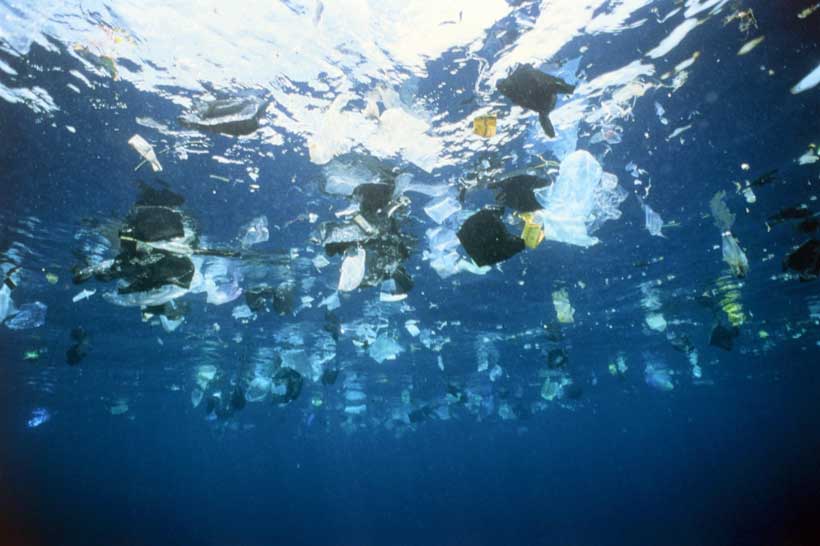Over 8 million tons of plastic pollute the oceans each year. The problem is so severe that, if nothing changes, there could be more plastic than fish in the sea by 2050.
We must urgently rethink how we make and use this ubiquitous material, now a staple of our modern economy. The appetite to take action is real: public and private sector financial commitments to combat ocean pollution made at the European Union's Our Ocean conference this year, for instance, totalled 7.2 billion euros. Yet if cleaning up is a short-term necessity, only a whole system reset will provide a long-term solution to plastics pollution and the economic losses associated with it.

Pollution is just one symptom of our hugely wasteful plastics system. It is an iconic example of our linear "take-make-dispose" economy as a whole. Forty years after the launch of the first universal recycling symbol, a report by the Ellen MacArthur Foundation to the 2016 World Economic Forum revealed that only 14 per cent of plastic packaging is collected for recycling globally: this results in a loss of $80 billion to $120 billion a year to the global economy.
Only a whole system reset will provide a long-term solution to plastics pollution and the economic losses associated with it.
Packaging is not the only culprit. The International Union for the Conservation of Nature has estimated that around half a million tons of plastic micro-fibres shed from the washing of plastic-based textiles like polyester end up in the ocean every year. The challenge is to reconcile the undeniable benefits of plastics and clothing, among other everyday products, with systems that work in the long-term and avoid pollution and the loss of valuable materials.
Can such a dilemma be solved by applying the principles of a circular economy? These are to design out pollution, keep materials in use, and build natural capital within a restorative and regenerative system. The circular economy could contribute significantly to achieving the Sustainable Development Goals which, since their adoption just two years ago, seem to be generating an unprecedented level of collaboration between private and public stakeholders.
The circular economy does not just apply to global streams of materials like plastics and textiles. Sustainable production and consumption may, at first glance, be the prime target of this system shift, but its reach is wider. Analysis from New Climate Economy, for instance, has shown that China's air quality targets can only be achieved by combining accelerated economic restructuring, energy conservation, fuel switching and environmental policy: even the strictest end-of-pipe treatment measures could only do half the job.
Similarly, the Ellen MacArthur Foundation has found that circular economy opportunities in India’s food system could, by 2030, yield a 15 per cent reduction in spending on food, while reducing carbon dioxide emissions and the use of synthetic fertilizers and pesticides (and their associated pollution) by 21 per cent and 45 per cent respectively. The circular economy provides a positive way forward on a wide range of issues, from helping urbanization take place in a way that benefits its citizens to preserving life below water.
Policymakers’ most potent tool is the ability to set high-level ambition, providing both a vision for a better system and visibility for industry.
Realising such benefits requires a concerted effort. Revolutions do not happen by decree, sopublic-private dialogue around policy design must be at the heart of any serious system shift. Policymakers have an important catalysing role in both setting a direction for industries, and in putting in place mechanisms to help them move faster. The Ellen MacArthur Foundation's Toolkit for Policymakers report provides a methodology to help structure such a transition.
Policy can be about setting the rules of the game. For plastics, for example, this could include being selective about the use of certain polymers, other chemicals or applications. Such action can be effective, cost little and garner public support. Rapid reductions in single use shopping bags – through bans or charges – have been achieved with little disruption in France, Rwanda, and the United Kingdom.
Restriction, however, is only part of the story. It must be complemented by mechanisms that foster innovation. Policymakers are well-positioned, as they can connect the design of plastic packaging with collecting, sorting and subsequently reusing or recycling it. The New Plastics Economy initiative, led by the Ellen MacArthur Foundation, aims to establish initial elements of a "Global Plastics Protocol" to address the industry’s need for common guidelines and standards in plastics design, use and reuse.
This would be a crucial step in getting all the industry actors involved in producing and using plastics packaging that can be either reused, recycled or composted – thus staying out of the environment. Policymakers’ most potent tool, however, is the ability to set high-level ambition, providing both a vision for a better system and visibility for industry. Clear signals indicating that the future will be materially different from the past must be sent to the market to help investment decisions.
The Sustainable Development Goals aim at a materially better future. We must think hard about what model of economic growth we want, since it will form the bedrock of that future. It must be fit for its purpose – promoting sustained, inclusive and sustainable economic growth, full and productive employment and decent work for all. There are several ways of looking at such a model but, whatever its complexion, it must build economic, societal, and natural capital rather than deplete it.
By Ellen MacArthur, Founder and Chair of Trustees, Ellen MacArthur Foundation